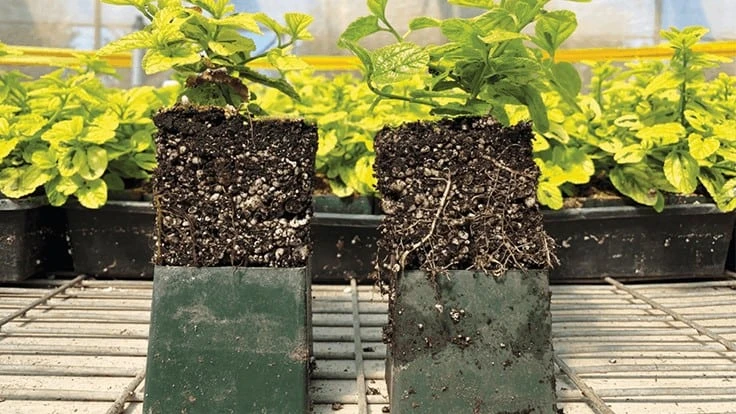

One application of mycorrhizae on most plants will allow these beneficial soil fungi to form a lifelong, symbiotic relationship between the mycorrhizae and the plant, says Blair Busenbark, sales and marketing manager at Mycorrhizal Applications.
“Mycorrhizae works to expand the root mass, and by expanding the root mass, the plant is better able to uptake water and nutrients,” he says. “Ultimately, it allows the plant to be less stressed.”
Expanding the root mass does not mean increasing the roots and making the plant root bound, Busenbark says, the expansion of the root mass comes with the expansion of the mycorrhizal hyphae into the soil. These mycorrhizal filaments can then take up water and nutrients from the rhizosphere that are otherwise inaccessible to roots and root hairs.
IMPROVED WATER UPTAKE
Water is stored in mycorrhizae’s myce¬lium, which leaves a reserve that prevents plants from wilting for 36 to 48 hours longer than they would be able to without mycorrhizae, Busenbark says. These water savings can help greenhouse and nursery growers save money.
“Just think about all the labor that you can save if you're not having to water consistently on hot days because you have that reserve in the plant,” he says.
MORE EFFICIENT FERTILIZATION
Simultaneously, mycelium can help plants better absorb and store nutrients for use when the plant needs them, Busenbark says.
“An example of this in min¬eral soil that often has high levels of phosphorus, but that is not available to the plant,” he says. “Mycorrhizae can transform that phosphorus that's not available and make it readily available to the plant.”
Similarly, mycorrhizae can also transform nitrogen from its ammoniacal form to the nitrate form that plants can use. This allows growers to use less fertilizer, Busenbark says.
MYCORRHIZAE AS AN INSURANCE POLICY
Stronger root systems crafted by mycorrhizae help plants avoid stress, Busenbark says.
“What happens when the plant goes into wilt?” he asks. “It puts forth stress, and when it puts out stress, the plant becomes vulnerable. Instead of focusing on flowering or fruiting, the plant has to focus on survival. That's less likely to hap¬pen if the plant has the mycorrhizae as a backup.”
Mycorrhizae is like an insurance policy, he says. Plants are likely to experience stress when they leave the greenhouse; stress can also happen in the greenhouse if somebody forgets to water or the temperature rises or drops to undesirable levels. The mycorrhizae help ensure plant health through tough times.
“The key part is that most people — unless they have a particular [problem] that's right in front of them, they don't know they have the problem, whereas mycorrhizae can help solve a lot of potential problems, like the fertilizer going through the pot that you're just wasting money on,” Busenbark says. “That's something that nobody consciously thinks about, but it's there.”

Explore the March 2020 Issue
Check out more from this issue and find your next story to read.
Latest from Greenhouse Management
- Anthura acquires Bromelia assets from Corn. Bak in Netherlands
- Top 10 stories for National Poinsettia Day
- Langendoen Mechanical hosts open house to showcase new greenhouse build
- Conor Foy joins EHR's national sales team
- Pantone announces its 2026 Color of the Year
- Syngenta granted federal registration for Trefinti nematicide/fungicide in ornamental market
- A legacy of influence
- HILA 2025 video highlights: John Gaydos of Proven Winners





